
The Orleans Collection was a very important collection of over 500 paintings formed by Philippe II, Duke of Orléans, mostly acquired between about 1700 and his death in 1723. Apart from the great royal-become-national collections of Europe it is arguably the greatest private collection of Western art, especially Italian, ever assembled, and probably the most famous, helped by the fact that most of the collection has been accessible to the public since it was formed, whether in Paris, or subsequently in London, Edinburgh and elsewhere.
The core of the collection was formed by 123 paintings from the collection of Queen Christina of Sweden, which itself had a core assembled from the war booty of the sacks by Swedish troops of Munich in 1632 and Prague in 1648 during the Thirty Years War. During the French Revolution the collection was sold by Louis Philippe d'Orléans, Philippe Égalité, and most of it acquired by an aristocratic English consortium led by Francis Egerton, 3rd Duke of Bridgewater. Much of the collection has been dispersed, but significant groups remain intact, having passed by inheritance. One such group is the Sutherland Loan or Bridgewater Loan, including sixteen works from the Orleans Collection, in the National Gallery of Scotland, and another is at Castle Howard, Yorkshire. There are twenty-five paintings formerly in the collection now in the National Gallery, London, which have arrived there by a number of different routes.
The collection is of central interest for the history of collecting, and of public access to art. It figured in two of the periods when art collections were most subject to disruption and dispersal: the mid-17th century and the period after the French Revolution.
Rudolf and Christina
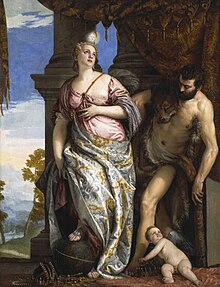
The paintings looted from Prague Castle had mostly been amassed by the obsessive collector Rudolph II, Holy Roman Emperor (1552–1612), whose own bulk purchases had included the famous collection of Emperor Charles V's leading minister Cardinal Granvelle (1517–86), which he had forced Granvelle's nephew and heir to sell to him. Granvelle had been the "greatest private collector of his time, the friend and patron of Titian and Leoni and many other artists", including his protégé Antonis Mor. The Swedes only skimmed the cream of the Habsburg collection, as the works now in Vienna, Madrid and Prague show.
Most of the booty remained in Sweden after Christina's departure for exile: she only took about 70 to 80 paintings with her, including about 25 portraits of her friends and family, and some 50 paintings, mostly Italian, from the Prague loot, as well as statues, jewels, 72 tapestries, and various other works of art. She was concerned that the royal collections would be claimed by her successor, and prudently sent them ahead to Antwerp in a ship before she abdicated.
Christina greatly expanded her collection during her exile in Rome, for example adding the five small Raphael predella panels from the Colonna Altarpiece, including the Agony in the Garden now reunited with the main panel in New York, which were bought from a convent near Rome. She was apparently given Titian's Death of Actaeon by the greatest collector of the age, Archduke Leopold William of Austria, Viceroy in Brussels - she received many such gifts from Catholic royalty after her conversion, and gave some generous gifts herself, notably Albrecht Dürer's panels of Adam and Eve to Philip IV of Spain (now in the Prado).
On her death she left her collection to Cardinal Decio Azzolino, who himself died within a year, leaving the collection to his nephew, who sold it to Don Livio Odescalchi, commander of the Papal army, at which point it contained 275 paintings, 140 of them Italian. The year after Odescalchi's death in 1713, his heirs began protracted negotiations with the great French connoisseur and collector Pierre Crozat, acting as intermediary for Philippe, duc d'Orléans. The sale was finally concluded and the paintings delivered in 1721. The French experts complained that Christina had cut down several paintings to fit her ceilings, and had over-restored some of the best works, especially the Correggios, implicating Carlo Maratta.
Royal owners
-
 Rudolf II, Holy Roman Emperor, 1552–1612, deposed by his family after he turned into a recluse
Rudolf II, Holy Roman Emperor, 1552–1612, deposed by his family after he turned into a recluse
-
 Christina of Sweden, 1626–1689, went into exile when she wanted to convert to Catholicism
Christina of Sweden, 1626–1689, went into exile when she wanted to convert to Catholicism
-
 Philippe d'Orléans, 1674–1723, Regent of France, who assembled the Orleans Collection
Philippe d'Orléans, 1674–1723, Regent of France, who assembled the Orleans Collection
-
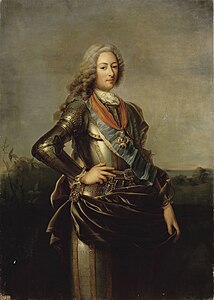 Louis, Duke of Orléans (1703–1752)
Louis, Duke of Orléans (1703–1752)
-
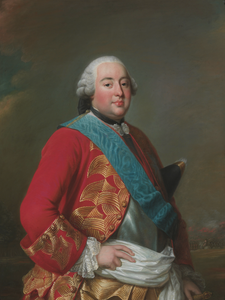 Louis Philippe I, Duke of Orléans
Louis Philippe I, Duke of Orléans
-
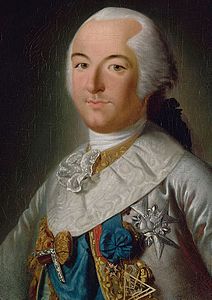 "Philippe Égalité", Louis Philippe II, Duke of Orléans, 1747–1793, guillotined in the Reign of Terror
"Philippe Égalité", Louis Philippe II, Duke of Orléans, 1747–1793, guillotined in the Reign of Terror
Collection in Paris

The Orleans collection was housed in the magnificent setting of the Palais-Royal, the Paris seat of the dukes of Orléans. Only 15 paintings in the printed catalogue of 1727 had been inherited by Philippe II from his father, Philippe de France, Duke of Orléans, Monsieur (1640–1701); the "collection" as catalogued was by no means all the art owned by the dukes, but recorded only that part kept together in the Palais-Royal for public viewing. He also inherited small but high quality collections from Henrietta Anne Stuart, his father's first wife, in 1701 and his father's lover, the Chevalier de Lorraine in 1702.
According to Reitlinger, his most active phase of collecting began in about 1715, the year he became Regent on the death of his uncle Louis XIV, after which he no doubt acquired an extra edge in negotiations. He also began to be presented with many paintings, most notably the three of Titian's poesies, now in Boston and shared by Edinburgh and London, which were given by Philip V of Spain to the French ambassador, the Duc de Gramont, who in turn presented them to the Regent.
Christina's collection only joined Philippe's shortly before the end of his life and most of the other works were bought in France, like the Sebastiano del Piombo Raising of Lazarus, with some from the Netherlands or Italy, like the Nicolas Poussin set of the Seven Sacraments, bought from a Dutch collection by Cardinal Guillaume Dubois in 1716. Other sources included the heirs of Cardinals Richelieu and Mazarin, and Cardinal Dubois, with an especially important group from Jean-Baptiste Colbert's heir the Marquis de Seignelay, and others from the dukes of Noailles, Gramont, Vendôme and other French collectors.
The paintings were housed in two suites of large rooms running side by side down the west or library wing of the palace, with the smaller Dutch and Flemish works in smaller rooms. The gallery suites of rooms still retained much of their original furniture, porcelain and wall-decorations from their use by Phillippe's father as grand reception rooms and according to a visitor in 1765 it was "impossible to imagine anything more richly furnished or decorated with more art and taste". Rearrangements had been made to accommodate the paintings; connoisseurs particularly praised the Galerie à la Lanterne, with its even, sunless top light diffused from the cupola overhead. For most of the 18th century it was easy to visit the collection, and very many people did so, helped by the printed catalogue of 1727, republished in 1737, Description des Tableaux du Palais Royal. This contained 495 paintings, though some continued to be added, and a few disposed of.

Paintings were hung, not by 'schools' or by subject but in order to maximise their effects in juxtaposition, in the 'mixed school' manner espoused by Pierre Crozat for his grand private collection in his Parisian hôtel. The mixture on a wall of erotic and religious subjects was disapproved of by some visitors. The collection was most notable for Italian paintings of the High and Late Renaissance, especially Venetian works. The collection included no fewer than five of the poesies painted for Philip II of Spain, of which two are now shared between Edinburgh and London, two always in London (Wallace Collection and National Gallery), and one in Boston. A series of four mythological allegories by Veronese are now divided between the Fitzwilliam Museum in Cambridge, and the Frick Collection (with two, one illustrated above) and Metropolitan Museum in New York. Another Veronese series, the four Allegories of Love now in the National Gallery, hung as overdoors in the central salon, which also held the larger Veronese series, three of the Titian poesies and Correggios.
The collection included (on the contemporary attributions) 28 Titians, most now regarded as workshop pieces but including several of his finest works, 12 Raphaels, 16 Guido Renis, 16 Veroneses, 12 Tintorettos, 25 paintings by Annibale Carracci and 7 by Lodovico Caracci, 3 major Correggios plus ten no longer accepted as by him, and 3 Caravaggios. Attributions no longer accepted, and probably regarded as dubious even then were 2 Michelangelos, and 3 Leonardos. There were few works from the 15th century, except for a Giovanni Bellini. The collection reflected the general contemporary confusion outside Spain as to what the works of the great Velázquez actually looked like; the works attributed to him were of high quality but by other artists such as Orazio Gentileschi.
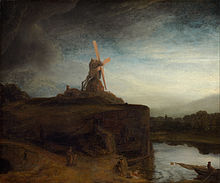
French works, of which the catalogued collection included relatively few, included a set of the Seven Sacraments and 5 other works by Poussin. There were paintings by Philippe de Champaigne now in the Wallace Collection and Metropolitan Museum of Art, and a Eustache Le Sueur which turned up in 1997 over a door in the Naval & Military Club and is now in the National Gallery. The Flemish works were dominated by Rubens with 19 paintings, including a group of 12 studies now widely dispersed, van Dyck with 10 works and David Teniers with 9. The Dutch paintings included 6 Rembrandts, 7 works by Caspar Netscher (one now Wallace Collection) and 3 by Frans van Mieris (one now National Gallery) that were more highly regarded then than they are now. There were 3 Gerrit Dous and 4 Wouwermans.
Philippe's son Louis d'Orléans, religious and somewhat neurotic, attacked with a knife one of the most famous works, Correggio's Leda and the Swan, now in Berlin, and ordered the painter Charles-Antoine Coypel to cut up all three of the great Correggio mythological works in the presence of his chaplain, which Coypel did, but saving and repairing the pieces. The Leda went to Frederick the Great of Prussia, the Danäe to Venice, where it was stolen and eventually sold to the English consul at Livorno, and Jupiter and Io went to the Imperial collection in Vienna. Some of the Flemish paintings were sold at auction in Paris, June 1727.
Beginning in 1785, a series of 352 engravings of the paintings were published on a subscription basis, until the series was abandoned during the Terror, by which time the paintings themselves had been sold. It was finally published in book form in 1806. These prints have greatly reduced the uncertainty that accompanies the identity of works in most dispersed former collections. There had already been many prints of the collection; the Seven Sacraments were especially popular among the middle classes of Paris in the 1720s.
Gonzagas and Charles I

Another famous collection whose history was entwined with the Orleans Collection was that assembled by the Gonzagas of Mantua, especially Francesco II (1466–1519) and his son Federico II (1500–1540). Their court artists included Mantegna and Giulio Romano, and they commissioned work directly from Titian, Raphael, Correggio and other artists, some of which were given as gifts to Charles V, Holy Roman Emperor, to whom Mantua was effectively a client state. The most important of these gifts were the mythological works by Correggio, later to be mutilated in Paris. By the early 17th century the dynasty was in terminal decline, and the bulk of their portable art collection was bought by the keen collector Charles I of England in 1625–27. Charles's other notable purchases included the Raphael Cartoons and volumes of drawings by Leonardo da Vinci, and his own most notable commissions were from Rubens and van Dyck. By the time his collection of paintings was seized and sold after his execution in 1649 by the English Commonwealth it was one of the finest outside Italy. Meanwhile, three years after the sale to Charles, Mantua was sacked by Imperial troops, who added much of what was left there to the Imperial collection in Prague, where they rejoined the diplomatic gifts of a century earlier.
Some Mantuan paintings therefore passed from Prague via Christina to the Orleans Collection, while more were bought by French collectors in the London "Sale of the Late King's Goods" in 1650, and later found their way to the Palais-Royal. For example, an Infancy of Jupiter by Giulio Romano, bought from Mantua, left Charles' collection for France, passed to the Orleans Collection and the London sales, and after a spell back in France returned to England and was later bought by the National Gallery in 1859.
Other paintings in the same series were recovered for the Royal Collection in 1660; Charles II was able to exert pressure on most English buyers of his father's collection, but those gone abroad were beyond his reach. One important Rubens of Charles', the Landscape with St George and the Dragon (of 1630 - St George has Charles's features, the rescued princess those of his Queen), which passed via the dukes of Richelieu to the Palais-Royal and London, had always been recognised for what it was, and was bought back for the Royal Collection by George IV in 1814.
Another picture commissioned by Charles, The Finding of Moses by Gentileschi, painted for the Queen's House, Greenwich, was returned to Charles' widow Henrietta Maria in France in 1660. By the time it entered the Orleans Collection a half-century later, it was regarded as by Velázquez. It then was one of the Castle Howard paintings, and was only correctly identified after the existence of Gentileschi's second version in the Prado became known in England. After a sale in 1995 it was on loan for nearly 20 years to the National Gallery until they bought it for £22 million in December 2019. Phillippe's father's first wife, Henrietta Anne Stuart, was Charles I's daughter, and her small but select collection had been mostly given to her by her brother Charles II from the reclaimed royal collection on her marriage in 1661. On her death forty years later this was left to Phillippe.
Dispersal in London
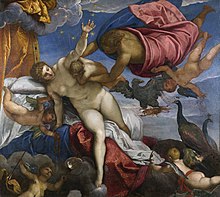
In 1787 Louis Philippe d'Orléans, the Regent's great-grandson, whose huge income could not keep pace with his gambling habit, had sold his equally famous collection of engraved gems to Catherine the Great of Russia, and in 1788 he was in serious negotiations with a syndicate organized by James Christie, founder of Christie's, the London auctioneer, for the sale of the paintings. Christie got as far as arranging that the collection should be made over to him upon the deposit of 100,000 guineas in the Bank of England, before the negotiations collapsed when the Prince of Wales having subscribed his name in the book for 7,000 guineas, and his brothers the dukes of York and Clarence for 5,000 each, no further subscribers were to be found. It was Dawson Turner's opinion that the failure was owing to the general sense that at the division of the spoils the lion's share would go to the royals.
In 1792 Philippe Égalité impulsively sold the collection en bloc to a banker of Brussels who immediately sold it at a huge profit to the enlightened connoisseur Jean-Joseph de Laborde de Méréville, who set about adding a gallery to house it attached to his hôtel in rue d'Artois. Ruined by events, he was forced to sell it once more.
The 147 German, Dutch and Flemish paintings were sold by Orléans to Thomas Moore Slade, a British dealer, in a syndicate with two London bankers and George Kinnaird, 7th Lord Kinnaird, for 350,000 livres in 1792, and taken to London for sale. There were protests from the French artists and public, and from the Duke's creditors, and Slade found it prudent to tell the French the pictures were going overland to Calais. In fact he had them moved onto a barge by night, and shipped them down the Seine to Le Havre. These paintings were exhibited for sale in the West End of London in April 1793 at 125 Pall Mall, where admissions at 1 shilling each reached two thousand a day, and sold to various buyers.
Philippe Égalité, as he had renamed himself, was arrested in April 1793 and was guillotined 6 November, but in the meantime sale negotiations for the Italian and French paintings were renewed, and they were sold for 750,000 livres to Édouard Walkiers, a banker of Brussels, who soon after sold them on, unpacked, to his cousin, Count François-Louis-Joseph de Laborde-Méréville, who had hoped to use them to add to the French national collection. After the start of the Reign of Terror, and the execution of his father as well as the Duke of Orléans, Laborde-Méréville saw he had to escape France, and brought the collection to London in early 1793.
The French and Italian paintings then spent five years in London with Laborde-Méréville, the subject of some complicated financial manoeuvres, including the failure of an attempt supported by King George III and the Prime Minister Pitt the Younger to buy them for the nation. They were finally bought in 1798 by a syndicate of the canal and coal-magnate Francis Egerton, 3rd Duke of Bridgewater, his nephew and heir, Earl Gower, later 1st Duke of Sutherland, and the Earl of Carlisle. Gower, who was perhaps the prime mover and must have known the collection well from his time as British ambassador in Paris, contributed 1/8 of the £43,500 price, Carlisle a quarter, and Bridgewater the remaining 5/8s.
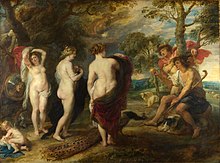
The pictures were put on exhibition for seven months in 1798, with a view to selling at a least a part of them, in Bryan's Gallery in Pall Mall, with the larger ones at the Lyceum in the Strand; admission was 2/6d rather than the 1s. usual for such events. On first seeing the collection there, William Hazlitt wrote "I was staggered when I saw the works ... A new sense came upon me, a new heaven and a new Earth stood before me." In 1798, 1800 and 1802 there were auctions of those paintings not sold via the galleries, generally achieving rather low prices, but 94 out of 305 of the paintings were retained by the syndicate, as seems always to have been intended, and these largely remain in their families today. However these paintings represented over half of the valuations placed on the whole portion bought by the syndicate. Even at the often low prices realized, the sales to others, and entry receipts to the exhibitions, realized a total of £42,500, so even allowing for the expenses of the exhibitions and auctions, the syndicate got their works very cheaply. Castle Howard, home of the Earls of Carlisle, originally had fifteen works, now much reduced by sales, donations, and a fire, but the Bridgewater/Sutherland group remain intact to a large degree.

The London market in these years was flooded by both other collections from France itself, and those dislodged by the French invasions of the Low Countries and Italy—by 1802 including Rome itself. As is often the case with old collectors, their choices of what to keep and what to sell seem in many cases very strange today: the two "Michelangelos" were only sold in the auctions, and for only 90 and 52 guineas. Many Titians were sold, but many Bolognese Baroque works, as well as most of the later (but not the earlier) Raphaels, were retained. The single Watteau went for only 11 gn, while one Carracci was valued at £4,000 for the galley sale, where all 33 Carraccis were sold, while works attributed to Giovanni Bellini and Caravaggio remained at the auction stage. The current location of many of the pictures can no longer be traced, and many are now attributed to lesser artists or copyists. Overall the prices realized for the better pictures were high, and in some cases their level would not be reached again for a century or longer. As an extreme case, a Ludovico Carracci valued at 60gn in 1798 was auctioned by the 5th Duke of Sutherland in 1913 raising 2gn.
An example of a work now only known from a replica (in the Galleria Borghese in Rome) and studies is Aeneas and his Family Fleeing Troy, the only secular history painting by Federico Barocci. The prime version was given in 1586 by Francesco Maria II, the last Duke of Urbino, to Rudolph II in Prague, and was later looted by the Swedes. It was taken to Rome by Queen Christina, passed to the Orleans collection, and finally sold at auction in London for 14 guineas in 1800 (the price probably reflecting the poor condition some sources mention), since when its whereabouts are unknown. The Rome version was painted in 1598, presumably for Cardinal Scipio Borghese.
The paintings of both portions of the collection were bought by a wide range of wealthy collectors, the great majority English, as the wars with France made travelling to London difficult for others. Major buyers included Thomas Hope, a Dutch banker (distantly of Scottish extraction) sheltering in London from the Napoleonic Wars, who with his brother (of Hope Diamond fame) bought the two large Veronese allegories now in the Frick Collection, and works by "Michelangelo", "Velásquez" and Titian, John Julius Angerstein, a Russian-German banker whose collection later became the foundation of the National Gallery and John Bligh, 4th Earl of Darnley.
An analysis by Gerard Reitlinger of "most" of the buyers (of the Italian and French pictures) divides them as follows:
- Nobility - 12, including the syndicate
- Merchants - 10, including 4 Members of Parliament and 3 knights; mostly as speculators according to Reitlinger - their purchases were mostly resold within a few years
- Dealers - 6, including Bryan, who handled matters for the syndicate
- Bankers - Hope and Angerstein (both foreign)
- Painters - 4: Walton, Udney, Cosway and Skipp
- Gentleman Amateurs - 6, including William Beckford and the critic Samuel Rogers.
- a breakdown he describes as "quite unlike anything in Europe and grotesquely unlike pre-revolutionary France", where the main collectors were the tax farmers. Many of the same figures appear in the similar list of buyers of the Northern paintings.
Much of our information about the sales comes from the Memoirs of Painting, with a Chronological History of the Importation of Pictures of Great Masters into England by the Great Artists since the French Revolution, by William Buchanan, published in 1824, of which the first 200 pages of Volume I are devoted to the Orleans sales, listing the works and most prices and buyers. Buchanan was himself involved in the import of art from 1802 onwards, and had his information from the dealers involved. He presents his own "exertions", and those of others, in the area in a thoroughly patriotic light, by implication as a part of the great national struggle with the French. Nicholas Penny notes the "somewhat comic" disparity between Buchanan's "sonorous words" on the subject and the "coarse and mercenary business letters" he reprints—many by himself.
Bridgewater collection

On Bridgewater's death five years after the purchase, he bequeathed his collection to Gower, who put it and his own paintings on at least semi-public display in Bridgewater House, Westminster; it has been on public display ever since. The collection contained over 300 paintings, including about 50 Orleans paintings, and was known as the "Stafford Gallery" in Cleveland House until the house was rebuilt and renamed as Bridgewater House in 1854, and then as the "Bridgewater Gallery". It was opened in 1803, and could be visited on Wednesday afternoons over four, later three, months in the summer by "acquaintances" of a member of the family (in practice tickets could mostly be obtained by writing and asking for them), or artists recommended by a member of the Royal Academy. Angerstein's paintings were on display on similar terms in his house in Pall Mall, which from 1824 became the first home of the National Gallery.
On the outbreak of the Second World War in September 1939, the collection was moved from London to Scotland. Since 1946 26 paintings, sixteen from the Orleans Collection, known collectively as "the Bridgewater loan" or "the Sutherland Loan" have been on loan to the National Gallery of Scotland in Edinburgh, though up to 2008 five from this group had been bought by the Gallery.
The collection has passed by descent to Francis Egerton, 7th Duke of Sutherland, (most of whose wealth is contained in the paintings collection), but in late August 2008 the 7th Duke announced that he wished to sell some of the collection in order to diversify his assets. He at first offered Diana and Callisto and Diana and Acteon, two works by Titian as a pair to the British national galleries at £100 m (a third of their overall estimated market price) over a period. The National Gallery of Scotland and the National Gallery in London announced they would combine forces to raise the sum, initially in the form of £50 m to purchase Diana and Actaeon paid over three years in instalments and then £50 m for Diana and Callisto paid for similarly from 2013. The campaign gained press support, though it received some criticism for the Duke's motives or (from John Tusa and Nigel Carrington of the University of the Arts) for distracting from funding art students In 2009 it was announced that the first £50M for Diana and Actaeon had been raised - the painting will rotate every five years between Edinburgh (first) and London. The sale of Diana and Callisto for £45M was announced in 2012.
Paintings with articles once in the collection

Titian
Poesie for Philip II
- Venus and Adonis, two versions, but not Philip's
- Perseus and Andromeda
- Diana and Callisto
- Diana and Actaeon
- The Rape of Europa
- The Death of Actaeon
Other
Other artists
- Colonna Altarpiece by Raphael
- The Raising of Lazarus , by Sebastiano del Piombo
- Jupiter and Io and Danaë by Correggio
- Origin of the Milky Way , by Tintoretto
- The Mill, by Rembrandt
- Allegory of Virtue and Vice, Allegory of Wisdom and Strength and Venus and Mars by Paolo Veronese
- Orléans Madonna by Raphael
Current locations
- National Gallery, London - at least 25 works, plus two currently on loan there.
- National Gallery of Scotland - sixteen works, including those on loan.
- Wallace Collection, London - 6 works
- Metropolitan Museum of Art, New York - At least three works, the Raphael Colonna Altarpiece and a predella panel, a Philippe de Champaigne, and a Veronese
- National Gallery of Art, Washington - four works by: Rembrandt, Ludovico Carracci, Sébastien Bourdon and ?Jan Cossiers (as well as two important works from other sources once in the collection of Earl Gower).
- Frick Collection, New York - two Veroneses (see above), two portraits of Frans Snyders and his wife by van Dyck
Other works are in: Berlin, Vienna, Dresden, Malibu, Paris, Rome, Boston (Titian The Rape of Europa), Tokyo, Kansas City, and many other cities.
Notes
- Louis-François Dubois de Saint-Gelais, 1727. Description des tableaux du Palais Royal avec la vie des peintres à la tête de leurs ouvrages, Preface. Reprinted 1737 and 1972 (Geneva). The descriptions are online at the Getty Provenance Index - choose Archival documents, and search with Orleans Collection in "Owner's name".
- Watson, 202, and Penny, 461 and Reitlinger, 26
- Penny, 463
- Penny gives a concise history of the collection in a few thousand words, with special reference to the paintings in the National Gallery. Watson covers the history from Prague to London in 175 pages; his book is the history of the Frick Veronese. From their bibliographies, there do not appear to be any full listings in English of the collections of Rudolf, Christina or the Dukes of Orléans, still less ones with current locations.
- ^ Penny, 466
- Penny, 461 lists 25, though for example the National Gallery catalogue for the Flemish School (Martin, 1970) lists other Orléans provenances that are not certain in the "Index of Previous Owners". There are also, in 2008, at least two further ex-Orleans paintings on loan to the National Gallery, a Guercino and the Gentileschi Finding of Moses, for which see below.
- Watson discusses both periods in "Interludes" at the end of his Parts 2 and 5. Reitlinger's Chapter 2 deals with the latter period.
- Trevor-Roper, 112. One Granvelle painting that seems to have made the full Prague-Stockholm-Paris-London journey is a version of the Correggio variously called The School of Love, The Education of Cupid or Venus with Mercury and Cupid, of which the prime version is now in the National Gallery. The prime version was bought by Charles I, then by the King of Spain in 1650, returning to England only in 1815 via the collections of Manuel de Godoy and Joachim Murat.
- A stray Veronese of Rudolf's, overlooked since his time, turned up in the castle in 1962.
- Watson, 127-9
- Watson, 158. The other panels are now in London: two at the Dulwich Picture Gallery and the other National Gallery; National Gallery page on the division of the Raphael altarpiece.
- Penny, 255. It is clearly shown in one of the Teniers' views of Leopold's galleries. Leopold's collection is now part of the Kunsthistorisches Museum in Vienna.
- Watson,168-9; Odescalchi was the nephew of Pope Innocent XI, though in fact his money was inherited and his career greatly improved after his uncle's death.
- Watson, 170
- Penny, 462-3, and Metropolitan
- ^ Penny, 462
- Watson, 196-7
- Penny, 462 & 464, and Watson, 185-6, who says Phillippe inherited over 550 paintings (including miniatures) from his father in all.
- Watson, 185-6.
- Reitlinger, 27, see also Watson, 185ff
- Brigstocke, 181 for the two "Diana" subjects in Edinburgh/London. He also bought the damaged Perseus and Andromeda (Wallace Collection), once owned by Anthony van Dyck, in France. See Ingamells, 1985.
- Penny, 462 and Robert W. Berger, 1999. Public Access to Art in Paris, "The Galérie d'Orléans, Palais Royal", pp 201-08.
- Buchanan, Vol I, 14 and in his listings, Penny and Watson passim
- ^ Penny, 464
- Penny, 462-5 has more details on the architectural setting
- Description des tableaux du Palais Royal avec la vie des peintres à la tête de leurs ouvrages, text by Louis-François Dubois de Saint-Gelais (1669-1737), who was later the secretary of the Académie royal de peinture et de sculpture; it was the first published catalogue of a French princely collection.
- Penny, 462. Buchanan lists several paintings from the catalogue that did not reach London.
- The 'mixed school' method of hanging had been established in the late seventeenth-century writings of André Félibien and Roger de Piles (Berger 1999:200).
- At least one work, The Holy Family with St John the Baptist now in the Sutherland Loan, has moved in the other direction, catalogued from 1727 until the 20th century as by Palma il Vecchio, but now seen as an early Titian. See Brigstocke, 171. For one old list of the Titians in the collection see A. Hume, 1827
- Reitlinger, 6-7, supplemented by Buchanan Vol I
- Watson, 251-3, Buchanan lists
- See the Finding of Moses discussed below.
- Wine Humphrey, National Gallery Catalogues (new series): The Seventeenth Century French Paintings, 2001, p. 226, National Gallery Publications Ltd, ISBN 185709283X National Gallery Archived 2009-02-07 at the Wayback Machine
- Numbers as sold in London: Buchanan, Vol I, pp. 167-9, 182-4 and 189ff respectively
- Numbers as sold in London: Buchanan, Vol I, pp. 196ff
- Reitlinger, 7
- Catalogue des tableaux flamands du cabinet de feu S.A.R. Mgr le duc d'Orléans, noted by Louis Courajod, Le livre-journal de Laurent Duvaux Paris, 1873, p, xx note.
- Galerie du Palais royal, gravée d'après les Tableaux des differentes Ecoles qui la composent: avec un abrégé de la vie des peintres & une description historique de chaque tableau, par Mr. l'abbé de Fontenai Dediée à S. A. S. Monseigneur le duc d'Orléans, premier prince du sang, par J. Couché. 3 vols. Paris: Jacques Couché, 1786-1808.
- Penny, 466. As was usual in French reproductive prints of the period, each plate was actually created in a mixture of etching and engraving.
- ^ Penny, 467
- Whitaker and Clayton, 30 have a short account of the sale, and French buyers. See also Further Reading.
- Now called The Infant Jupiter guarded by the Corybantes on the Island of Crete, and attributed to Giulio's workshop only. National Gallery Archived 2005-11-07 at the Wayback Machine. Where this painting was between inventories of Charles in 1637 and the Palais-Royal catalogue of 1727 remains unclear - it was not apparently in the Royal Collection at Charles' death. See Gould, 119.
- Royal Collection
- Lloyd, 104 Royal Collection
- National Gallery: Saved for the Nation; National Gallery Press Release Archived 2009-01-07 at the Wayback Machine
- Watson, 186
- Penny, 160-161
- Penny 466, Watson, 225, Reitlinger, 27. The Duke had other large costs, but there seems a consensus that his gambling losses predominated
- William T. Whitley, Artists and Their Friends in England 1700-1799, (London, 1928) vol. II, pp 179f.
- Louis Courajod , Le livre-journal de Lazare Duvaux, Paris, 1873:xx reported a purchase price of 750,000 livres and a sale price within days of 900,000 to Laborde.
- Slade's letter to Buchanan, quoted in Buchanan, Vol I, 163; Wheatley, op. cit. p. 180.
- Penny, 466. Buchanan's account, mainly a long letter from Slade, begins at Volume I, p. 159; £100 a day was taken in shillings at the door, according to Slade.
- Watson, 241-4; Penny, 466 7 note 69, p. 469. He died in London in 1802.
- See Penny, 466
- Penny, 466-7, though Reitlinger, 32 appears to be applying these fractions to the three promoters' purchases, and has £43,000 as the purchase price.
- In On the Pleasure of Painting, 1820, quoted in Watson, 251. See also Penny, 467
- Penny, 467; Reitlinger, 32
- Reitlinger, 32, but see also Penny, 467 and notes 81 & 84 on p. 470 for different figures.
- Castle Howard website Archived 2006-09-29 at the Wayback Machine
- Reitlinger, Chapter 2 and Watson, 254-66
- Watson, 252-53.
- Reitlinger, footnote p. 26, for this example, and passim. He has much information on subsequent price movements.
- Turner, 109;Image of the replica version in Rome; engraving in the Metropolitan Museum of Art
- Watson, 253. The "Velásquez" Discovery of Moses is now an Orazio Gentileschi (Penny, 463) and the Titian a rather dubious attribution
- Reitlinger, 30, and 16 on the farmers
- Buchanan, Vol I, 165
- Memoirs of Painting online text also republished in 2008 by Read Books
- As he describes in Vol II, he specialized in buying in Genoa, from where he obtained several very important Rubens and van Dycks, and Spain, where he bought the Rokeby Venus and other works.
- See, for example, Vol II, pp. 248-9
- Penny 467-8
- Victorian London-Bridgewater House
- Penny, 468
- Brigstocke, 11
- Brigstocke, 11, plus subsequently the Titian Venus Anadyomene in 2003
- He had previously sold another Titian from the loan — the Venus Anadyomene — to the National Gallery of Scotland in 2000.
- Bates, Stephen (28 August 2008). "Art auction: National galleries scramble to keep Titians as duke cashes in". The Guardian. London. Retrieved 2008-08-28.
- "Editorial: In praise of... the Bridgewater loan". The Guardian. London. 28 August 2008. Retrieved 2008-08-28.
- "National Galleries of Scotland press release". Archived from the original on 2012-02-19.
- Jones, Jonathan (31 October 2008). "Enough vulgar Marxism - we must keep Titian's masterpiece". The Guardian. London. Retrieved 20 November 2008.
- Thorpe, Vanessa (16 November 2008). "Arts chiefs warn of harm from Titian crusade". The Observer. London. Retrieved 20 November 2008.
- "Second part of £95m Titian pair bought for Britain". The Guardian. 1 March 2012.
- Indices of Previous Owners in Catalogues by Ingamells, 4 vols, 1985-92
- Metropolitan
- Metropolitan - this one only entered the collection in about 1788, and though listed among those for despatch to England, was not in the end included in the bulk sale
- Metropolitan
- NGA Provenance Index - Orleans Archived 2009-05-09 at the Wayback Machine
- NGA Provenance Index - Gower Archived 2008-10-10 at the Wayback Machine
References
- Brigstocke, Hugh; Italian and Spanish Paintings in the National Gallery of Scotland, 2nd Edn, 1993, National Galleries of Scotland, ISBN 0903598221
- Buchanan, William; Memoirs of Painting, with a Chronological History of the Importation of Pictures of Great Masters into England by the Great Artists since the French Revolution, 1824, Ackermann, London, published in 1824 (of which the first 200 pages of Volume I are devoted to the Orleans sales, listing the works and most prices and buyers) Memoirs of Painting online text also republished in 2008 by Read Books
- Gould, Cecil, The Sixteenth Century Italian Schools, National Gallery Catalogues, London 1975, ISBN 0947645225
- Lloyd, Christopher, The Queen's Pictures, Royal Collectors through the centuries, National Gallery Publications, 1991, ISBN 978-0-947645-89-2
- Penny, Nicholas, National Gallery Catalogues (new series): The Sixteenth Century Italian Paintings, Volume II, Venice 1540-1600, 2008, National Gallery Publications Ltd, ISBN 1857099133
- Reitlinger, Gerald; The Economics of Taste, Vol I: The Rise and Fall of Picture Prices 1760-1960, Barrie and Rockliffe, London, 1961
- Trevor-Roper, Hugh; Princes and Artists, Patronage and Ideology at Four Habsburg Courts 1517-1633, Thames & Hudson, London, 1976
- Turner, Nicholas, Federico Barocci, 2000, Vilo
- Watson, Peter; Wisdom and Strength, the Biography of a Renaissance Masterpiece, Hutchinson, 1990, ISBN 009174637X
Further reading
- Schmid, Vanessa I (ed), The Orleans Collection, 2018, D Giles Ltd, ISBN 9781911282280
- Cristina di Svezia, Le Collezioni Reali (exhibition catalogue), Mondadori Electa, Milan, 2003, ISBN 8837024045
- Folliot, Franck, Forray, Anne, and Mardrus, Françoise; articles in Le Palais-Royal (exhibition catalogue), Musée Carnavalet, Paris 1988
- Macgregor, Arthur, ed.; The Late King's Goods. Collections, Possessions and Patronage of Charles I in the Light of the Commonwealth Sale Inventories, Alistair McAlpine / Oxford University Press, 1989, ISBN 0199201714
- Brotton, Jerry. Sale of the Late King's Goods: Charles I & His Art Collection, Macmillan, 2006, ISBN 1405041528
External links
- The Bridgewater Syndicate Web feature from the National Gallery
- The Bridgewater Collection: Its Impact on Collecting and Display in Britain Lecture by Susanna Avery-Quash, Research Curator in the History of Collecting: delivered at the National Gallery 7 December 2009